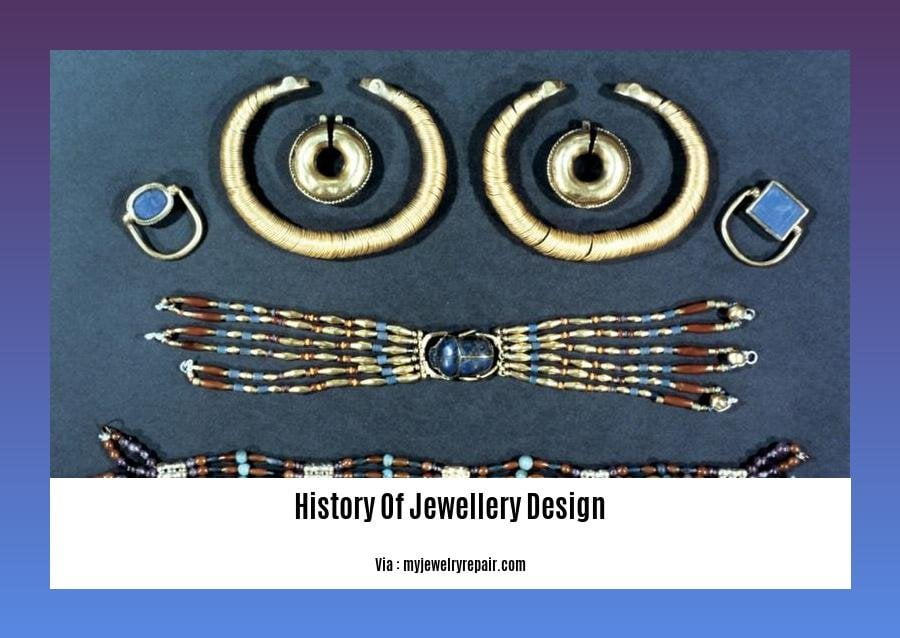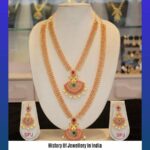Step into the mesmerizing world of jewellery design, where artistry, culture, and adornment intertwine to create a captivating narrative. From ancient talismans to modern masterpieces, each piece holds a unique story, revealing the evolution of human creativity and societal influences. Join us on a journey through time, as we unravel the enchanting history of jewellery design, exploring the intricate artistry, symbolic meanings, and cultural significance that have shaped this captivating art form.
Key Takeaways:
- Antique:
- Over a century old.
Intricate designs and craftsmanship.
Art Nouveau:
- 1890-1910 trend.
Organic forms and asymmetry.
Renaissance:
- 1400-1700.
- Intricate metalwork and gemstones.
Inspired by classical motifs.
17th Century:
- Period of opulence and grandeur.
Large gemstones, pearls, and elaborate settings.
Victorian:
- 1800s to early 1900s.
- Romantic and sentimental styles.
- Intricate gold work and colorful gemstones.
History of Jewellery Design


Throughout history, jewellery has served as a canvas for artistic expression, storytelling, and cultural identity. Tracing the history of jewellery design reveals a rich and diverse tapestry of styles, techniques, and influences that have shaped this enduring art form.
Ancient Origins:
Jewellery’s roots can be traced back to the dawn of civilization, with early examples dating back to 5000 BC. Ancient cultures, from the Egyptians to the Romans, fashioned ornaments from a variety of materials, including gold, silver, gemstones, and bone. These early adornments held both aesthetic and symbolic significance, often serving as talismans, amulets, and status symbols.
Medieval Splendor:
The Middle Ages witnessed a flourishing of jewellery design, with intricate metalwork and gemstone settings reaching new heights of artistry. Byzantine jewellery, in particular, was renowned for its vibrant enamel work and intricate goldsmithing, while Gothic jewellery reflected the era’s fascination with symbolism and religious iconography.
Renaissance Revival:
The Renaissance period brought about a revival of interest in classical art and culture, which had a profound impact on jewellery design. Jewellers drew inspiration from ancient Greek and Roman designs, creating pieces characterized by symmetry, balance, and a newfound emphasis on naturalism.
The Georgian Era:
The 18th century, known as the Georgian era, saw the rise of elaborate and opulent jewellery designs. Georgian jewellers favored bold gemstones, such as diamonds and rubies, set in intricate gold and silver mounts. This period also witnessed the introduction of new techniques, such as the closed-back setting, which allowed for more secure and durable gemstone settings.
Victorian Elegance:
The Victorian era marked a return to sentimental and romantic jewellery styles. Jewellers incorporated motifs such as hearts, flowers, and ribbons into their designs, often using gemstones and enamel to create intricate and colorful pieces. The invention of the safety clasp during this period also made it possible for women to wear heavier and more elaborate necklaces and bracelets.
Art Nouveau and Deco:
The late 19th and early 20th centuries saw the emergence of new and innovative jewellery design movements. Art Nouveau jewellery was characterized by its organic forms, asymmetry, and use of unconventional materials, such as horn and enamel. Art Deco jewellery, on the other hand, embraced geometric shapes, bold colors, and a luxurious aesthetic, reflecting the glamour and opulence of the Roaring Twenties.
Contemporary Expressions:
In the contemporary era, jewellery design has become a platform for artistic experimentation and self-expression. Jewellers today draw inspiration from a wide range of sources, including art, architecture, and nature, to create pieces that are both visually striking and conceptually engaging. Contemporary jewellery often pushes the boundaries of traditional design, incorporating new materials, techniques, and technologies.
Throughout the history of jewellery design, jewellery has evolved from mere adornment to a powerful form of artistic expression and cultural identity. The exquisite craftsmanship, intricate designs, and symbolic meanings embedded in jewellery have captivated hearts and minds for centuries, making it an enduring and timeless art form.
You can learn more about the origin, evolution, and regional diversity of Indian jewelry by tracing its history of jewellery in india, spanning over 5,000 years.
In addition, you can explore the history of jewellery making in India, which showcases the diverse techniques, craftsmanship, and artistry employed by Indian jewelers throughout history, leading to the creation of exquisite jewelry designs.
History Of Jewellery Design In The World
Our journey through the mesmerizing evolution of jewellery design is an exploration of art, culture, and adornment. From ancient talismans to contemporary masterpieces, each era and civilization has left its unique mark on the world of jewellery.
Ancient World: Jewellery’s earliest forms emerged in the ancient world, where adornments served both functional and symbolic purposes. From the intricate gold work of the Egyptians to the beaded necklaces of Mesopotamia, these early creations showcased the craftsmanship and artistry of ancient civilizations.
Medieval Era: During the Middle Ages, jewellery became a symbol of wealth and status. Elaborate gold and silver pieces adorned the nobility, while intricate metalwork and gemstones were used to create religious artefacts.
Renaissance and Baroque: The Renaissance and Baroque periods witnessed a resurgence of interest in classical motifs and intricate craftsmanship. Jewellery became more elaborate, featuring enamel work, gemstones, and pearls.
Georgian and Victorian Eras: The Georgian and Victorian eras brought a focus on sentimental and romantic styles. Jewellery was often crafted from gold and silver, and featured intricate filigree work and gemstones.
Art Nouveau and Art Deco: The Art Nouveau and Art Deco movements introduced new design elements, such as organic forms, asymmetry, and geometric patterns. Jewellery from these periods is characterized by its bold and striking designs.
Modern and Contemporary: The 20th century saw a departure from traditional jewellery styles, with the rise of modern and contemporary design. New materials, such as plastics and stainless steel, were used to create innovative and unconventional pieces.
Key Takeaways:
- Jewellery design has evolved over time, reflecting cultural, social, and artistic influences.
- Ancient jewellery served functional and symbolic purposes, while medieval jewellery symbolized wealth and status.
- Renaissance and Baroque jewellery featured intricate craftsmanship and classical motifs.
- Georgian and Victorian jewellery was sentimental and romantic in style.
- Art Nouveau and Art Deco introduced bold geometric and organic designs.
- Modern and contemporary jewellery embraces new materials and unconventional styles.
Source 1: The History of Jewelry Design
Source 2: A Brief History of Jewelry Design
FAQ
Q1: How did jewellery design evolve throughout history?
A1: Jewellery design has undergone a remarkable journey, mirroring the artistic, cultural, and technological shifts of each era. From ancient adornments symbolizing power and status to intricate masterpieces reflecting personal expression and innovation, the evolution of jewellery design showcases the enduring creativity and craftsmanship of humanity.
Q2: What are some of the notable historical periods in jewellery design?
A2: Throughout history, several periods stand out for their distinctive jewellery styles. These include the Art Nouveau era with its organic forms and asymmetry, the Renaissance with its intricate metalwork and gemstones inspired by classical motifs, the Victorian era known for its romantic and sentimental styles, and the Art Deco period characterized by geometric patterns and bold colors.
Q3: What factors influenced the development of jewellery design in different historical periods?
A3: The evolution of jewellery design was influenced by various factors, including cultural beliefs, technological advancements, and societal changes. Symbolism and religious beliefs played a significant role in ancient jewellery, while the availability of new materials and techniques such as enamel and stone carving shaped designs in later periods. Social factors like wealth, status, and personal expression also influenced the development of jewellery styles.
Q4: How has jewellery design reflected the artistic and cultural movements of its time?
A4: Jewellery design has often mirrored the artistic and cultural movements of each era. For example, the Art Nouveau period’s jewellery echoed the organic forms and natural motifs popular in Art Nouveau art, while the bold geometric shapes of Art Deco jewellery reflected the era’s fascination with modernity and industrialization.
Q5: What are some of the most iconic jewellery pieces from different historical periods?
A5: Many iconic jewellery pieces have emerged throughout history, embodying the unique characteristics of their respective periods. Examples include the intricate gold and gemstone pieces of the Renaissance, the pearl and diamond necklaces of the 17th century, the sentimental lockets and cameos of the Victorian era, and the bold and geometric designs of Art Deco jewellery. These iconic pieces continue to inspire and captivate audiences with their artistry and historical significance.
- China II Review: Delicious Food & Speedy Service - April 17, 2025
- Understand Virginia’s Flag: History & Debate - April 17, 2025
- Explore Long Island’s Map: Unique Regions & Insights - April 17, 2025
















